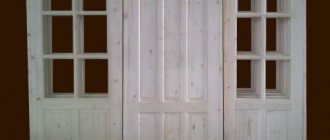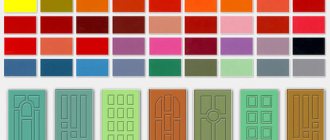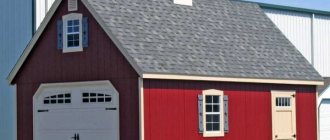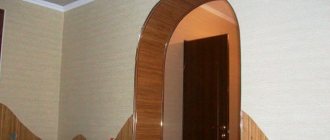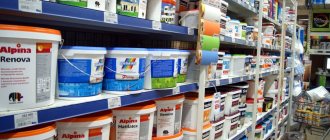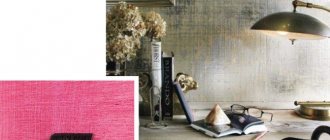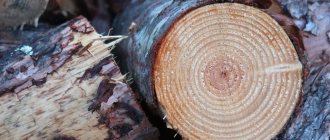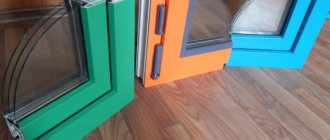New MDF doors or old wooden doors can be given an aesthetic appeal by painting them to look like wood. To do this, you need to preserve or create the natural beauty of the structure of natural wood on the door leaf. It is very important to choose a special paint that would allow you to achieve this goal. Professional craftsmen recommend using opaque enamels and paint compositions containing acrylic, perchlorovinyl, polyurethane, oil or alkyd bases. Varnishes, stains or special oil impregnations can help refresh the color of wood or give it a different shade. Water-based acrylic paints have good consistency and provide good coloring of the material; alkyd dyes have optimal water-repellent properties, resistance to temperature fluctuations, and quick drying.
Types of wood dyes
- Texture coating, such as Aquatex. It is intended for decorative finishing of wood, allowing it to be given a shade of color characteristic of valuable wood species. The coating protects the material from moisture, rotting processes, damage by fungi or wood insects. They can be pre-treated as an antiseptic before applying other types. Application is carried out on a dry surface. If there is an old coating on it, it is removed by scraping or sanding. The composition is available in a wide variety of colors from colorless to dark brown. To obtain the desired shade, different formulations can be mixed. At the same time, it must not be diluted or mixed with other paint coatings.
- Acrylic varnish, for example German, imitating the appearance of noble wood species. Protects the material from biological damage, cracking, exposure to moisture and ultraviolet rays. It is environmentally friendly, odorless, dries quickly, prevents the growth of fungi, has thixotropic properties - there are no traces of painting tools or drips on the treated surface, it can be washed many times. Tinting using Coltec Wood and Trox catalogs allows you to give it 140 shades.
- Primer-paint “Premia”, intended for restoration of wooden surfaces. Easily restores wood damaged by insects or darkened by age; it can be applied to previously untreated or painted surfaces. It can also be used on dark varnished wood to give it a light color. If you use it as an independent coating, you can get the result of “bleached wood”. This paint contains an antiseptic that protects against microorganisms and fungi destructive to wood; it is environmentally friendly and resistant to adverse atmospheric factors. Penetrating deep into the wood, it strengthens the surface layers, giving them adhesive strength.
- Tekotex protective and toning composition. Thanks to the fungicide content, it protects the wood surface from rotting and mold. Tints in shades characteristic of noble wood species. The presence of light-resistant pigments in the composition protects against the influence of solar radiation, and the elastic film created on the surface of the material protects from atmospheric moisture.
Advantages and disadvantages
Panels made of false beams are connected like a lock. Their natural color depends on the type of wood from which they are made: light species - pine, larch, dark ones - ash, oak, beech.
The parameters of the panels imitating timber allow them to be adjusted to surfaces with large and small cubic capacity:
| Name | Dimensions |
| Thickness | 16-37 millimeters |
| Width | 110 millimeters and more |
| Length | 2-6 meters |
According to the type of processing, natural and thermowood are divided. The second type of panels has lower thermal conductivity and is less susceptible to rotting.
General positive aspects of false beam siding:
- the finishing is safe for health and the environment, since the panels are made of environmentally friendly material;
- less weight compared to natural timber, so the imitation can be mounted on bases not intended for heavy loads;
- heat and noise insulation increases indoors; it is not necessary to lay insulating material between the wall and the imitation panels;
- Thanks to the locking connection, the panels are quickly installed and easily replaced if damaged.
False timber is a rare finishing material with a short list of disadvantages:
- easily flammable, like any wooden products;
- sensitive to harmful atmospheric influences.
A few disadvantages can be eliminated by painting and varnishing. Imitation timber is popular due to a large number of advantages, which also include a wide range of prices for different types of wood and beauty.
Door painting
The dyeing process consists of several stages. In this case, two different compositions are often used. Before applying the decorative coating, the surface of the material is covered with impregnation; it may or may not have a tinting effect. An important role is played by the correct selection of compounds that, when used together, will give excellent results. For example, you cannot combine applying a layer of drying oil and subsequent varnish treatment. In this case, instead of drying oil, you need to use stain. When using only stain or impregnation, they are applied in two or three layers, depending on the condition of the surface being treated. Dyes based on alkyd resin can only be applied to dry material. If its surface is wet at the time of painting, the paint will subsequently begin to peel off, and air bubbles will form underneath, causing it to peel off.
Sequence of work
The design of the door includes not only its leaf, but also the jambs, as well as the lintel. In the preliminary stage of work, all these parts of the door are properly prepared so that after painting they do not differ in tone from each other. To do this, the canvas is removed from its hinges and placed on an object suitable for its placement, which can be used as a trestle, a table or two stools. When using an alkyd composition with a pungent unpleasant odor, it is better to do the work outdoors, located in the courtyard of the house, on an open, well-ventilated terrace or balcony. If for some reason you do not want to remove the panel, you can insert wedges into the gap separating it from the jamb to provide brush access to the surface of any door element. This type of blocking will also help to avoid closing the door before it is completely dry to avoid damaging the applied paint layer. It is also advisable to dismantle the fittings. If the hinges and handles are not removable, they can be protected from paint using paper and tape, wrapping them around these parts, or using foil for this purpose. Gluing a piece of tape to it will help protect the lock mechanism.
Advice for those who are planning to paint a metal surface at sub-zero temperatures
Although this advice may apply more to ordinary painting than decorative painting, situations are different. For example, you need to immediately paint a part that has just been brought in from the cold. Therefore, we will give some tips:
- The best way to paint in cold weather is to use alkyd enamels with a jelly-like consistency that have high adhesion (the ability to penetrate the surface structure);
- Painting a surface cooled to temperatures below +5 degrees Celsius should be done exclusively with preliminary treatment of this very surface with a torch or heat gun. Otherwise, condensation will form on the surface on which the paint simply will not adhere;
- If the room itself is cold when painting, the drying time of the layer can increase several times, which is especially unpleasant for decorative painting. Therefore, it is recommended to install a heat gun and cover the surface with film.
Preparing the door
This stage is very important and consists of several processes:
- All previously applied layers - paint, primer, putty - are removed from the surface of the material. To do this, you can use a grinding machine or make your own device, consisting of a block that fits comfortably in your hand, onto which medium-grain sandpaper is nailed or glued on one side. There are also simpler options - heat the surface with a hair dryer, as a result of which the paint layer will begin to lag behind, swelling with bubbles, and remove it with a spatula, or moisten the painted surface with a special remover.
- Primary polishing of the door, smoothing out small dents, scratches, and removing paint residues. This process is performed with a machine or medium-grit sandpaper.
- Putty for eliminating large imperfections. If you plan to cover the door with a transparent color, such as varnish, oil or stain, you should choose a putty whose color matches the wood. When painting with opaque enamel, you can use putty of any color. Be sure to fill the cracks at the junctions of decorative elements with the canvas and the lintels with the jamb.
- At the end of the curing period specified by the putty manufacturer, sanding is performed again with sandpaper. First, an abrasive material having a medium grain is used, then a fine-grained sandpaper is used. To fill deep dents in the material, you can use auto filler that does not contain fiberglass. If the surface of the wood has darkened while it was under a layer of paint, it can be lightened a little by treating it with bleach containing bleach dissolved in water. Use one part bleach to three parts water.
Standard DIY painting process
Necessary materials and tools
- putty knife;
- brush;
- old paint remover;
- putty;
- dye.
Preparation and the painting process itself
- Inspect the door for possible faults.
- Fix any problems if you find them.
- Remove the swollen and cracked layer of old paint using a putty knife. For this purpose, you can also use special chemical industry products (caustic sodium or carbolic acid) if the paint is removed unevenly. To find out which product is best to choose, consult with the seller of the construction supermarket.
- Wash the door thoroughly.
- Let it dry completely.
- Using a putty knife and putty, repair all existing cracks and chips.
- Let it dry.
- Remove all fittings. If this is not possible, then cover them with protective film.
- Remove the door from its hinges.
- Place it on a horizontal surface. This way you will be able to avoid smudges and achieve uniform coloring.
- Paint one side of the door.
- Let dry thoroughly.
- Turn the door over and do the same with the other side.
- Once dry, complete the process by painting the sides.
Coloring
After the material is cleared of the old coating and protruding putty, it should be vacuumed, wiped with a damp cloth, dried and painted. The door can be painted evenly with paint of one tone or a pattern can be created on it that imitates the structural lines of natural solid wood. Also, its surface can be artificially aged. To uniformly paint the door, a sprayer is used, or if it is not available, a panel brush or roller is used. Before painting begins, fluff the brush, allowing loose bristles to fall out. The painting scheme depends on the type of door structure. Painting a panel door is done in three stages. It is better to use a roller for this: it will paint the surface evenly, without sticking bristles. It is better to start applying paint from the end bordering the upper corner of the canvas on the left side, directing the roller from left to right. Having finished painting, you should wait until it dries, allowing for the amount of time specified in the manufacturer's instructions. The second stage of painting is performed in a vertical direction, and the third - horizontally, but in the opposite direction relative to the first layer. For a paneled door, you should use a brush, when passing it into the recesses of the panel, do not pick up an excess amount of paint on it in order to avoid the formation of smudges. The painting is completed by using a roller in the same way as for a panel door.
Painting
Before starting decorative work, a primer is applied to the base using any painting tool and left until dry. You can create wood-like decor on dried soil with your own hands in three ways:
- when using a special grater;
- by mixing liquid paints;
- method of applying soot.
When deciding how to paint a door to look like wood or decorate any other piece of furniture with your own hands, everyone chooses the most convenient method for themselves.
Using a rubber float
This is the easiest way to decorate with your own hands; it is preferred by most beginning craftsmen . It consists of the following stages:
- The selected light enamel color is applied and left until completely dry.
- After the light paint has dried, a dark layer is applied on top of it, but you should not wait for it to dry completely. As soon as the dye has dried a little, take a rubber grater with a relief pattern cut out on it, imitating a cut of wood, and with its help, while the paint is still liquid, characteristic marks in the form of streaks and grooves are left over the entire surface. The light color showing through the dark layer creates the illusion of a woody structure. This drawing is left until completely dry.
- The finished item is varnished, preferably in 2-3 layers, dried and installed in place.
If you have doubts about your decorating abilities, then you can practice using a grater on unnecessary grounds.
Liquid mixing
This technique is a little more difficult for beginners. Here you need an artistic flair and a sense of color, and this method can only be used on relatively large, flat areas. But do not neglect this technique, because with its help you can create an amazing wood pattern. The sequence of actions is as follows:
- Light-colored enamel is applied and slightly dried. There is no need to wait long, because for the next stage the base dye needs to be wet.
- Take a brush. If the first layer can be applied with any painting tool, then a brush is required for the second. Using a brush, apply a dark layer on top of the first, still liquid, layer. Mixing paints while working with a brush produces stains that resemble a wooden cut.
- After drying, the resulting pattern is varnished.
Applying soot
This method is very simple and is most often used to decorate plastic in car interiors, but other materials can also be painted in this way. This technique requires enamel of only one color, preferably dark, and a plastic stick; many take a fork or spoon from a set of disposable tableware for this purpose. The work is carried out in the following way:
- Automotive plastic parts or other objects intended for decoration are painted in the selected color and left to dry completely.
- A stick or any other thin unnecessary plastic object is set on fire. As soon as the plastic product begins to smoke, you can draw with it by simply bringing it to certain areas of the surface. The random arrangement of dark, uneven soot spots allows you to get an original decor.
- The resulting result is varnished in 2-3 layers, and after complete drying the item can be used for its intended purpose.
You can create the illusion of a wooden structure on any basis; thanks to the proposed methods, you can get a stylish and expensive-looking front door or an original car interior, or simply inexpensively update a boring interior and give new life to your old favorite things.
Wood staining method
Before starting work, two types of paint are prepared:
- The main one, which may have, for example, a yellow tint.
- Auxiliary - paint of a different color, for example brown.
The door is prepared using the technology described above; it is necessary to remove it from its hinges in order to position it horizontally. The surface ready for painting is successively coated with two or three layers of base paint using a brush or roller. When they are completely dry, proceed to the next stage, which involves using auxiliary paint. It is applied in a thin layer to the base and, without waiting for it to dry, use a special elastic grater with teeth to remove part of the applied paint. The grater is moved longitudinally along the door leaf. This is similar to combing your hair with a comb. The resulting pattern is similar to the structure of wood. When the paint has dried, it can be coated with foundation varnish.
What determines the choice of paint?
Each of the listed paints has both pros and cons, and therefore the choice should be based on how the front door will be used. In particular, if, for example, paint will be applied to an old layer, it is not recommended to choose nitro enamel or water-based emulsion, which do not adhere well to an unprepared surface.
The easiest way is to paint from an aerosol can. By spraying, the paint is applied in an even layer to the surface, leaving no streaks or unpainted areas.
Of course, the aesthetic side of the issue is also of great importance. However, given the huge range of paints, you definitely won’t have any problems choosing the right shade. The main thing is that the color of the door matches at least a little with the color scheme in which the house is painted.
Pho Bua technology
French technology that allows you to create an imitation of rare or expensive wood. A base layer is applied to the prepared surface, which is usually acrylic paint. After drying, it is sanded and coated with a mixture consisting of pre-calcined hemp oil and white spirit in a ratio of 1 to 6. Then glaze is applied, which includes white spirit, turpentine, powder dyes or whitewash. To apply the composition in wavy lines, use a wide brush or sponge. To make the texture more pronounced, you can cover the surface with several layers of glaze. After the coloring solution has dried, varnish is applied.
How to paint metal
Imitation of wood can be done even on metal products, including doors made of this material. The technology for preparing metal products is no different from preparing for painting doors made of other materials.
The metal surface is pre-coated with a high-adhesive primer.
Preparation for painting includes the preliminary selection of fire retardant paint for metal. When painting products that will be used outdoors, use paint that will reliably protect against corrosion and is electrically protective.
As for color solutions, the street door is painted to match the color of the facade.
It is best to use powder paint to paint metal to look like wood. It is used in many industrial sectors and in everyday life.
This technology allows you to create an attractive design look for the treated surfaces of products.
Powder paint is applied to the surface using a special sprayer in the preparation chamber. The decoration process is carried out in a thermal chamber at high temperature.
This finish colors doors and other surfaces in Kale and Cremona oak, cherry, Calvados, pine, walnut and beech. A painted door is difficult to distinguish from a product made of natural wood. Any metal coating can be imitated as oak, acacia, walnut and other options.
As a result of the work carried out, the product retains all the advantages of metal and takes on the appearance of natural wood.
Decorating metal products to imitate wood is carried out during the interior design process. Painting technology involves several stages, including proper preparation.
The preparatory process includes:
- degreasing the surface and removing contaminants;
- treatment of the product against corrosion;
- actually, the painting process itself.
After the surface is degreased, a layer of matte paint is applied to it. You need to apply it with a brush, moving along the texture. After the paint has completely dried, a second layer is applied. The result is products that perfectly imitate wood.
The paint is applied in short, scratchy strokes, giving the piece the right texture.

